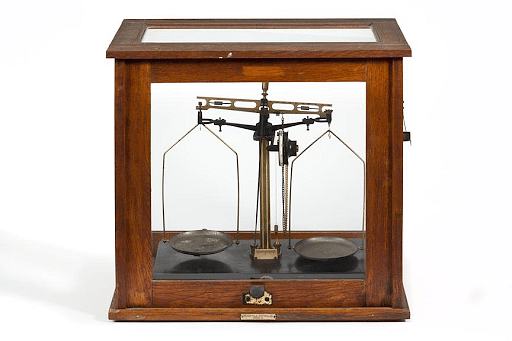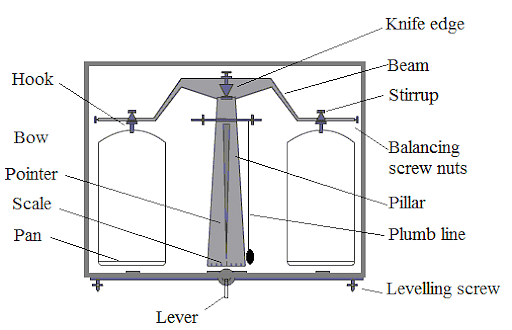
Content Strategy Manager
Chemical Balance is known to be a delicate instrument of beam balance that is used for the quantitative measurement of the chemical and it plays a very significant role in analyzing the chemical reactions. The specific characteristic of this kind of instrument is that it helps in weighing the small amounts of substances accurately. The measurement up to the fourth place of decimal is taken very aptly. The preparation of the standard solutions through these different kinds of chemicals is done properly and in a standardized manner with the help of a chemical balance. The volumetric analysis is also an outcome of using this tool of measurement of the chemical amounts. Given below is the theory, apparatus setup and the procedure for chemical balance along with the weighing balance principle, weighing balance uses and different types of balances.
| Table of Content |
Key Takeaways: Chemical Balance, Weighing Balance, Chemical Reaction, Fractional Weight Box, Analytical Balances, Types of Balance, Quantitative Analysis, Decimals, Oxalic Acid, Sodium Carbonate
What is Chemical Balance?
[Click Here for Sample Questions]
Chemical balance is an instrument that is used in Chemistry for preparing the balanced chemical reaction. It helps in volumetric analysis and the quantitative analysis of the chemicals which are to be used in the standardised chemical reaction. Furthermore, we can understand this chemical balance with the help of a chemical reaction of standard solutions as given below.

Chemical Balance
Aim
To set up a chemical balance for the preparation of standard solutions like oxalic acid and sodium carbonate in qualitative analysis.
Theory
The balance is a laboratory instrument that was built for measuring weight. It is said that the name for the same has been derived from the mechanical devices that are known to utilize the given weights to balance the object. Further, this object with the defined weight is to be weighed across a fulcrum. The usage of balance helps in making an accurate quantitative analysis. The substances that weigh not more than 200g can be measured easily through the analytical balance within the quantitative analysis and can be used for weighing substances not heavier than 200g., however, the least count is said to be around 0.0002g.
Similarly, there is an electronic balance that uses an electromagnet for balancing the object to be weighed on a single pan. At the same time, it is considered that a piece of weighing paper can be conveniently used to weigh a chemical that too sans determining the weight of the paper. When the balance of the weighing paper on the pan is zeroed, it is referred to as Taring.
Moreover, the balance is an instrument that is better enclosed in a glass case and gets protection from dust, air movements etc. The balance has its base to rest on screws and the edges and agate plates rest in a position horizontal to each other, attached by means of a plumb bob connected with the balance column.
An analytical balance is a kind of balance that measures the weight of four or five digits to the right of the decimal point. The single pan electronic analytical balance is generally used in the modern laboratory almost exclusively for precision. The weights are arranged in the order of 50, 20, 20, 10, 5, 2, 2, 1 in the weight box. And this box also contains a rider made of thin wire that is placed on the beam along with a hook that is connected with the balance.
Also Check: Difference Between Mass and Weight
Material Required
- Chemical balance
- Weight box
- Weight tube
- Substance to be weighed
- Watch glass
Setup of Apparatus

Procedure
- Firstly, the ray of the beam should be raised slowly and it should be taken care that the pointer is swinging at equal distances on both sides of the zero mark.
- Secondly, before taking weights on the pan, try to adjust the balance.
- Make sure that the balance is not overloaded.
- Watch glass or weighing bottle shall be used for measuring the wet substance as it should not be directly kept on the pan.
- Similarly, the hot substance should not be put to be measured.
- The side doors of the balance shall be only used for weighing.
- Lastly, always make sure to use the same balance for weighing different substances as this would further help in reducing error.
Rider
Rider is a loop of an aluminium wire weighing up to 10 mg. It acts as the sliding pointers placed at the top of the beams. Its main function is to show the weight of the pan and beam in units of a gram.
Result
The given substance is to be weighed using the chemical balance for preparing a standard solution.
Precautions
- All the appliances and chemicals must be handled with care.
- Do not bring the thumb closure to the pipette. Instead, close the index finger to it.
- Try not to knock out the last drop of the solution from the glass jet end of the pipette.
- The lower end of the pipette shall be held in the liquid while being sucked.
- Make sure that the stopcock of the burette is not leaking.
- Place the eye precisely on the solution’s meniscus level in order to read.
Also Check: Measurement Of Mass and Weight
What is the Weighing Balance Principle?
[Click Here for Sample Questions]
Electromagnetic force restoration (EMFR) is a phenomenon on which the weighing balance principle works. The coil arm is the weight laid on one side of the weighing balance and is also attached to the other arm. It functions by trying to move out of the range of the electromagnetic force of the magnetic field. Electrical regulator accompanies in passing the high current through the coil. And this high range of voltage-current keeps the weighing balance in a neutral position.
Uses of Weighing Balance
[Click Here for Sample Questions]
There can be multiple uses of weighing balance. Some of them are mentioned below.
- The Pharmaceutical industry is known for using the Weighing balance.
- Another major industry known for using this weighing balance is the food industry.
- Chemical industries which prepare medicines and other chemical-related items also use this weighing balance for proper measurement.
- The higher accuracy of the chemical balance makes it perfect for being used in various laboratories like biology laboratories, chemistry laboratories, and so on.
Different Types of Balance
[Click Here for Sample Questions]
There are majorly four types of balance, such as
- Analytical Balance
- Spring Balance
- Micro Balance
- Carat Balance

Analytical Balance
Also Check: Magnetic Force and Magnetic Field
Factors Affecting the Readings of Weighing Balances
[Click Here for Sample Questions]
There are various factors that affect the reading on weighing balances, some of these are mentioned below.
- Vibrations
- Air draft
- Temperature
- Magnets
- Uncalibrated scales
- Slope
- Chemical reactions
- User error
- Improper handling of the weights
- Improper grounding
Also Check: Unit of Temperature
Fractional Weight Box
[Click Here for Sample Questions]
A fractional weight box is a box that consists of all the tools which are usually required for the measurement. Such as rider, forceps, and a standard weight, all these ranges in grams and milligrams. It accompanies the weight measurement through chemical balance. Aluminium, wood, and plastic are usually the three most important elements out of which this fractional weight box is generally made. Moreover, the standard weights inside the box are mostly made up of copper or aluminium.
Things To Remember
- Chemical balance acts as an instrument that is used in various laboratories and industries for weighing even the minute quantities of chemicals.
- The entire purpose of this chemical balance is to prepare accurate standards of solution.
- It is known that the earliest weighing balances were made up of wood instead of metals, still performed similar functions that too appropriately.
- Beam balance was the first mass measuring instrument that was invented.
- Beam balance is an instrument that mainly has two arms of the same size having a pan suspended on each of the arms.
Sample Questions
Ques. State one difference between the chemical balance and the physical balance. (3 Marks)
Ans. Both the chemical and the physical balance contributes to measuring the weight of the substances. However, it is said that the chemical balance is comparatively sensitive to the physical balance. Chemical balance is also known for weighing small amounts of substances accurately and the measurement up to the fourth place of decimal is taken very aptly.
Ques. Define the term standard solution. (3 marks)
Ans. A standard solution is a term that is majorly used in analytical chemistry. This term is usually applied to describe the accurate quantity of elements present in a solution. The usage of a fixed quantity of chemicals in any pre-defined solution makes it a standard solution. A known solvent weight is dissolved in order to create a particular standardised quantity. And this is finally done with the help of the primary standard.
Ques. Briefly explain about Riders. (3 Marks)
Ans. A rider is made up of an aluminium wire which is turned into a loop with an entire weight of not more than 10 mg. It is mainly known to act as the sliding pointers which are usually placed at the top of the beams. The very significant function performed by the rider is to show the weight of the pan and beam in the unit of a gram.
Ques. Explain the reason behind closing the front door of the balance during weighing. (3 Marks)
Ans. There are multiple factors that affect the reading while weighing. One of these factors is air current, in order to avoid the disturbance by the air current, the front door is preferred to be closed. Similarly, the disequilibrium is also created by the incoming dust and dirt, therefore, in order to achieve the complete balance, the front door must remain close. Closing the front door of the balance shall have a direct impact on the reading and will help in recording the accurate one.
Ques. What can be the reason behind using chemical balance for measuring weight indirectly? (2 Marks)
Ans. An analytical balance is known to be extremely vulnerable as it measures the weight of even a single grain mass of a chemical. Therefore, in order to hold the substances, some tared container is used rather than placing the chemical directly on the pan.
Ques. Define fractional weight box. (3 Marks)
Ans. A fractional weight box is a box that is made up of Aluminium, wood, and plastic. The box consists of all the important tools which are usually required for the measurement, like, rider, forceps, and standard weight. It accompanies the weight measurement through chemical balance. Moreover, these standard weights which are found inside the box are generally made up of copper or aluminium.
Ques. Mention a few factors that affect the reading of weighing balance. (3 Marks)
Ans. The factors that affect the reading of a weighing balance are several and these have a severe impact on the final readings, becoming a reason for errors. Some of these factors are as follows.
- Vibrations
- Air Draft
- Temperature
- User Error
- Slope
- Improper handling of the weights
Ques. Briefly explain the uses of weighing balance. (3 Marks)
Ans. Weighing balance has various uses such as primarily it used in the Pharmaceutical Industry, food industry and also in the chemical industries which prepare the solutions and other chemical-related items via weighing balance for proper measurements.
Weighing balance is also known for its higher accuracy which also makes it perfect to be used in various laboratories like biology laboratories, chemistry laboratories, etc.





Comments